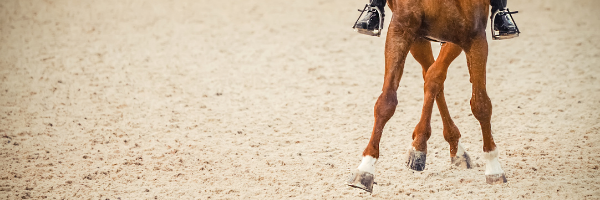 Web Content Viewer
Web Content Viewer
Don't Horse Around with Osteoarthritis!
Published on 9/29/21

By Sabrina Tarchione, BA
Osteoarthritis (OA) is a degenerative joint disease characterized by cartilage breakdown, osteophyte formation, joint capsule alteration and synovial membrane inflammation1, 2. Patients range in age, athleticism, and breed and can have a variety of symptoms like lethargy, lameness, stiffness, weight gain, changes in behavior, and reluctance to run, jump, or play. Many of these symptoms are a result of joint pain.
OA is divided into two categories: primary and secondary. Primary OA occurs progressively and is known as the wear-and-tear category while secondary OA occurs with acute trauma to the joint. Primary OA can be difficult for horse owners to diagnose because of the avascular (lacking blood supply) and aneural (lacking nerves) properties of cartilage3, 4, 5. Due to the lack of nerve signaling, cartilage damage can go unnoticed because the horse isn’t experiencing pain yet. However, as trauma to the joint capsule continues, a cascade of inflammatory mediators will rush to the damaged joint and the joint will become swollen and painful. This is when the owner starts to see symptoms such as lethargy, lameness, and reluctance of movement.
When evaluating the joint health of your equine companion, it is best to be proactive against OA. Major areas of preventative care are weight management or weight loss, exercise, and nutrition.
1. Weight management or weight loss. Ensuring your horse is at their optimal weight prevents unnecessary strain on weight bearing joints that can cause mechanical wear-and-tear6, 7. When extra weight is shifted onto areas of cartilage incapable of sustaining such loads, systematic inflammation ensues, causing joint pain. Talk to your veterinarian if you are concerned about your horse’s weight.
2. Exercise. Regular exercise is important preventative care because joint loading is essential for the joint maintenance of healthy cartilage7. As joints go through their range of motion cartilage is compressed and the pressure changes deliver nutrients from synovial fluid into the cartilage matrix. Exercise also strengthens muscles and ligaments around the joint, which can help protect the joint and lessen the pressure on weaker joints.
3. Nutrition. Foods that have anti-inflammatory constituents and antioxidants have been shown to mitigate/delay the effects of OA. Pro-inflammatory mediators such as omega-6 are attracted to damaged joints8. By digesting foods with anti-inflammatory properties like omega-3s, the inflammatory mediators are neutralized, decreasing inflammation and alleviating pain9, 10. Antioxidants neutralize reactive oxygen species (ROS) that can damage healthy cells. By donating electrons to ROS that are positively charged, free radicals have no need to steal from cellular membranes, preventing damage to cell membranes.
Supplementation is another prevalent component of nutrition. Natural supplements have become popular amongst horse owners and veterinarians but there is little evidence to support their joint strengthening capabilities. Popular joint supplements typically include chondroitin sulfate and glucosamines. However, there is a lot of mixed evidence that supplemental chondroitin sulfate and glucosamines support joint health.
Products utilizing a proprietary extract of Biota orientalis have been shown to increase chondrocyte proliferation and decrease inflammatory mediators Prostaglandin E2 (PGE2) and Nitric Oxide (NO) in vitro and in vivo11, 12, 13. Using the osteochondral fragment-exercise model, researchers have evidence that products utilizing a proprietary extract of Biota orientalis have disease and symptom modifying effects on OA13. This means products utilizing a proprietary extract of Biota orientalis do not just alleviate symptoms of OA (inflammation, pain, etc.) but also mitigate the effects of the disease. Products utilizing a proprietary extract of Biota orientalis offer a natural option for OA prevention and treatment that not only manages pain but stimulates chondrocyte proliferation.
Consult your veterinarian before supplementing your horses.
References:
1Sellam, J. and Berenbaum, F. (2010) The role of synovitis in pathophysiology and clinical symptoms of osteoarthritis. Nature Reviews Rheumatology 6:625-635.
2Scanzello, C.R. and Goldring, S.R. (2012) The role of synovitis in osteoarthritis pathogenesis. Bone 51(2):249-257.
3Iwamoto, M., Ohta, Y., Larmour, C. and Enomoto-Iwamoto, M. (2013) Towards regeneration of articular cartilage. Birth Defects Res C Embryo Today 99(3):192-202.
4Akkiraju, H. and Nohe, A. (2015) Role of chondrocytes in cartilage formation, progression of osteoarthritis and cartilage regeneration. Journal of Developmental Biology 3(4):177-192.
5He, Y., Li, Z., Alexander, P.G., Ocasio-Nieves, B.D., Yocum, L., Lin, H. and Tuan, R.S. (2020) Pathogenesis of Osteoarthritis: risk factors, regulatory pathways in chondrocytes, and experimental models. Biology 9(194).
6Thatcher, C.D., Pleasant, R.S., Geor, R.J. and Elvinger, F. (2012) Prevalence of overconditioning in mature horses in southwest Virginia during the summer. Journal of Veterinary Internal Medicine 26:1413-1418.
7Chen, L., Zheng, J.J.Y., Li, G., Yuan, J., Ebert, J.R., Li, H., Papadimitriou, J., Wang, Q., Wood., Jones, C.W. and Zheng, M. (2020) Pathogenesis and clinical management of obesity-related knee osteoarthritis: impact of mechanical loading. Journal of Orthopaedic Translation 24:66-75.
8Thomas, S., Browne, H., Mobasheri, A. and Rayman, M.P. (2018) What is the evidence for a role for diet and nutrition in osteoarthritis? Rheumatology 57:iv61-iv74.
9McIlwraith, C.W. (2010) Management of Joint Disease in the Sport Horse. Proceedings of the 2010 Kentucky Equine Research Nutrition Conference.
10Caron, J.P., Gandy, J.C., Brown, J.L. and Sordillo, L.M. (2019) Omega-3 fatty acids and docosahexaenoic acid oxymetabolites modulate the inflammatory response of equine recombinant interleukin1β-stimulated equine synoviocytes. Prostaglandins & Other Lipid Mediators 142:1-8.
11Pearson, W., Orth, M.W., Karrow, N.A. and Lindinger, M.I. (2008) Effects of simulated digests of Biota orientalis and a dietary nutraceutical on interleukin-1-induced inflammatory responses in cartilage explants. American Journal of Veterinary Research 69(12).
12Pearson, W., Orth, M.W. and Lindinger, M.I. (2009) Evaluation of inflammatory responses induced via intra-articular injection of interleukin-1 in horses receiving a dietary nutraceutical and assessment of the clinical effects of long-term nutraceutical administration. American Journal of Veterinary Research 70(7).
13Seabaugh, K.A., Frisbie, D.D., Barrett, M.F. and McIlwraith, C.W. (2020) Examining the effects of an extract of Biota orientalis in the osteochondral fragment – exercise model of osteoarthritis. AAEP Proceedings 66.